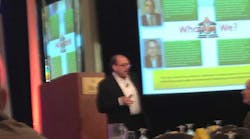NASHVILLE, Tenn. — For any manufacturer, large or small, lean transformation is a complex multiyear project—one that will languish if the company doesn't have buy-in from its entire workforce, from the C-suite to the production floor.
A key element in fostering staffwide commitment to the transformation is the establishment of a training program aimed at developing a "pipeline" of lean leaders to shepherd the project along.
The Lean Leadership Academy set up shop 10 years ago to do exactly that: help companies create training programs aimed at efficiently developing lean leaders within their workforce.
At the recent Lean HR Summit in Nashville, LLA Executive Director Sam MacPherson explained how the academy combines elements of the Toyota Production System and the leadership training program of the U.S. Army Special Forces to help manufacturers develop lean leaders.
"To have a successful lean transformation, you have to have three clear things: a solid business case for that transformation; a proper lean operating model; and dedicated time and resources to properly develop the leaders that will lead that model," MacPherson said. "It requires all of the above, plus you have to identify your organization's need for this early enough so that you have time to develop that leadership pipeline."
MacPherson cautioned against falling into the trap of becoming a zealot who "falls in love with the lean tools" and hastily implements those tools one at a time in lockstep sequence.
"We've all been guilty of this at some point," he said. "You know: 'How quickly can I put together a PowerPoint presentation on this tool, get it implemented, and then move on to the next tool?' But oftentimes these one-lane zealots don't have the authority or the responsibility for operational performance. And then it can get too departmentalized and turn into a situation like what killed TQM: 'Quality is that guy's job, not mine.' "
"That's why it's so important to institutionalize the lean transformation and build career paths around it."
Speedy Turnaround
Before co-founding the Lean Leadership Academy, MacPherson spent three years as director of training with the U.S. Army Special Forces Command. A key thing he learned from that experience is the importance of being able to quickly train and prepare people for leadership roles in which they can be deployed anywhere in the world at the drop of a hat.
"Much like the way Toyota invests heavily in leadership training, we did the same thing at Special Forces," MacPherson said. "We really invest in those front-line leaders. But the key difference is you have to do it very quickly. You don't get ramp-up time."
"When you come out of the Special Forces Qualification Course, you must be immediately deployable anywhere in the world," he said. "There's no honeymoon period. It could be a matter of finishing the course today and tomorrow you're on a plane and you're going to be sitting down across the table from a hardened warlord."
The Lean Leadership Academy's approach takes the best of the Toyota Production System's thorough, careerlong leadership development and melds it with the Special Forces' quicker pace.
"Rarely do we find an integrated mentoring methodology that says as you go up a career path you have someone mentor you in that role, and for the next role, and the next one," he said. "Toyota does this very well."
"But I will tell you, and so will many of my Toyota counterparts: It takes too long. Because the timeline around leadership development in their mentoring system is built around minor model changes and major model changes, and that only happens in two- and five-year stints."
Conversely, MacPherson said, it takes only 12 to 24 months to develop leaders in the Special Forces.
"We saw that we needed to basically look between those time frames and see if we could find a way to at least start feeding the leadership pipeline within 12 to 18 months," he said. "And we've had some success with that."
Commitment from the company's top brass is the most crucial element, MacPherson said.
"It communicates the right message throughout the organization when the senior leader leads," he said. "Not as a gentleman farmer, but right in there with his sleeves rolled up. As Kiichiro Toyoda would say, like he had to wash his hands three times before he sat down to lunch."




